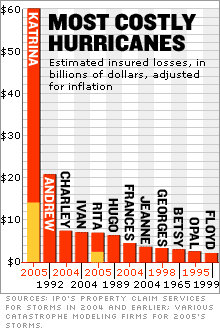 |
| A flooded refinery in Port Arthur, Texas, following the hit by Hurricane Rita. Insured losses from the storm could reach $7 billion, according to one early estimate. |
|
 |
|
|
|
|
NEW YORK (CNN/Money) -
Hurricane Rita apparently caused far lower insured losses than did Hurricane Katrina, but it may still prove to be one of the nation's most costly storms.
Early damage estimates from three major catastrophe risk modeling companies put insured losses at between $2.5 billion to $7 billion in eastern Texas and western Louisiana. That would be far less than earlier feared when Rita was a Category 5 hurricane headed towards the Galveston-Houston area last week. It came ashore as a category 3 hurricane in the less populated area near the Texas-Louisiana border.
Still one of the firms, Risk Management Solutions, put the insured losses at between $3 billion to $5 billion in onshore damage resulting from wind, storm surge, and rainfall-related flood hazards, with another $1 billion to $2 billion in damage to offshore oil platforms and lost production. Losses of $3 billion would be enough to make this the 10th most costly storm in U.S. history, when earlier storm damage is adjusted for inflation. A loss of $7.0 billion would be enough to make it the fifth most costly storm, just behind 2004's Hurricane Ivan.
RMS said the damage is comparable to Hurricane Charley, which generated an estimated $7.5 billion in insurance claims in August 2004, making it the second most costly storm at that time, behind only Hurricane Andrew in 1992. Since then, Hurricane Katrina may have produced insured losses of between $14 billion to $60 billion. The wide range of estimates is because the costs of Katrina are still being compiled.
"Hurricane Rita is comparable to last year's Charley in that its damage is spread across a low population density region of agricultural and fishing- related industries," said Kyle Beatty, a meteorologist with RMS. "There is also notable damage to offshore platforms, refineries and by-products industries of petroleum manufacturing."
One of the other firms that estimates insured losses, AIR Worldwide, said Saturday Rita costs will be in the $2.5 billion to $5 billion range.
"The heavy commercial and industrial areas of Port Arthur and Beaumont -- with their numerous refineries -- were to the left of the storm's track, where wind speeds are lower, so we do not expect to see significant structural damage to the refineries," Jayanta Guin, vice president of research and modeling at AIR Worldwide, said in a statement. (For more on damage to refineries, click here).
AIR also said the locations worst-hit by Rita had fewer insured properties in general than the areas ravaged by Katrina, contributing to the lower loss forecast.
There was still heavy damage, though, in communities like Beaumont, Texas, and Lake Charles, La., along with the prospect of flooding as Rita stalled and dumped heavy rains on the region.
Eqecat, another of the major catastrophe modeling companies, said Saturday Rita caused insured losses from wind damage in the neighborhood of $3 billion to $6 billion. Friday the firm had forecast that Rita could potentially be responsible for up to $18 billion in losses.
120 mph winds
Rita slammed into evacuated towns and oil-rich swamplands of the Texas-Louisiana border early Saturday, causing widespread damage and power outages. The powerful storm hit with 120 mph winds and punishing rains, then weakened slightly as it moved inland.
Houston, the fourth largest U.S. city, was spared a direct hit, which had insurers and reinsurers breathing a sigh of relief Saturday.
"I think for the complex in the Houston area, I would have to assume it is going to be minor if anything, just because the storm moved far enough east," said Bruce Jefferis, managing director of the natural resources unit at AON, the top global reinsurance broker.
But the oil city of Beaumont, Texas, and many of the largest U.S. refiners were in Rita's path, and the extent of damage was not yet known, nor was it clear how badly Rita damaged production in the nearby Gulf of Mexico.
"I'm fairly concerned right now about what's happened offshore, because Rita took a worse path for the offshore assets than Katrina did," Jefferis said. "The worst part of the storm would have been on the east side, which would have been right up the concentration of the assets."
Texas emergency management officials said they had airborne assessment teams ready to go out and inspect damages as soon as winds died down. At least one energy expert feared the worst, though, given Rita's track and previous intensity.
"It was right up production alley," said Harry Quarls, senior managing director of the global energy practice at Booz Allen Hamilton. "It was a Category 4 and 5 (storm) when it was going through."
-------------
Two big refineries report damage but the total impact on oil facilities is unclear. More here.
Rita poses risks to the economy far beyond Gulf Coast oil refineries. Click here for more.

|